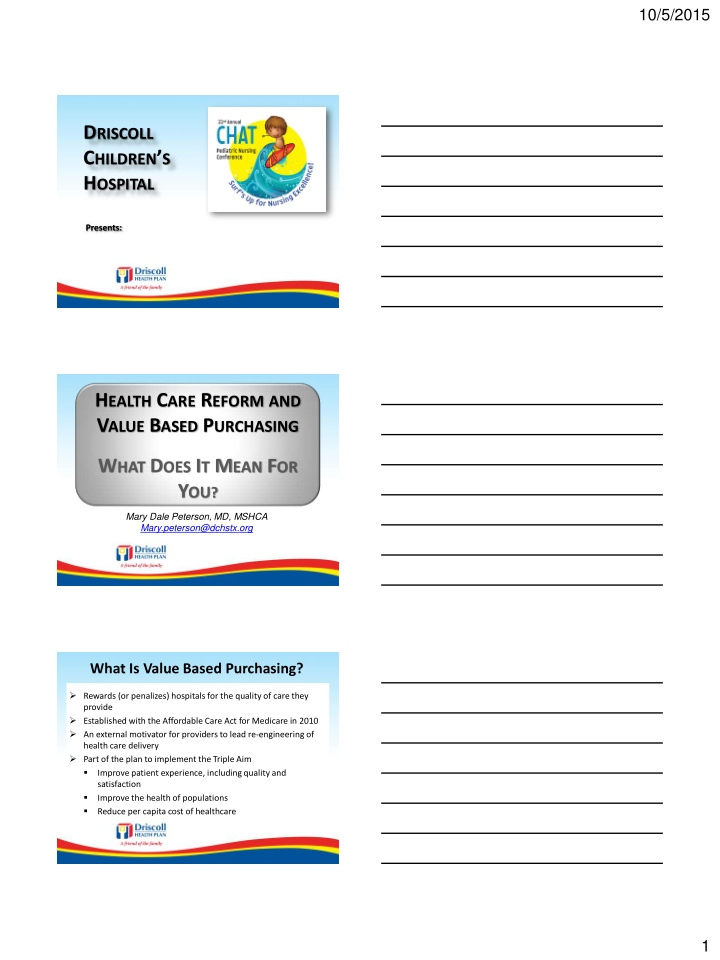



10/5/2015 D RISCOLL C HILDREN ’ S H OSPITAL Presents: H EALTH C ARE R EFORM AND V ALUE B ASED P URCHASING W HAT D OES I T M EAN F OR Y OU ? Mary Dale Peterson, MD, MSHCA Mary.peterson@dchstx.org What Is Value Based Purchasing? Rewards (or penalizes) hospitals for the quality of care they provide Established with the Affordable Care Act for Medicare in 2010 An external motivator for providers to lead re-engineering of health care delivery Part of the plan to implement the Triple Aim Improve patient experience, including quality and satisfaction Improve the health of populations Reduce per capita cost of healthcare 1
10/5/2015 What Is The Cost Of Health Care In The US? a) 10% of GDP? b) 14% of GDP? c) 18% of GDP? d) 20% of GDP U.S. Healthcare Spending On Track To Hit $10,000 Per Person This Year Forbes Jan. 4, 2015 What Are Our Outcomes For Our Spending? U.S. Healthcare Ranked Dead Last Compared To 10 Other Countries’ Healthy Lives: The U.S. ranks last overall with poor scores on all three indicators of healthy lives — mortality amenable to medical care, infant mortality, and healthy life expectancy at age 60. (The Commonwealth Fund) 2
10/5/2015 How is Texas Medicaid using VBP? Penalties for Potentially Preventable Readmissions within 15 days • Normal Newborn • Bronchiolitis and RSV Pneumonia • Appendectomy Penalties for Potentially Preventable Complications • UTI • C. Difficile Colitis • Moderate Infections • Accidental Puncture/Laceration during Invasive Procedure • Acute Pulmonary Edema What Are The Penalties ? 1-2.5% reduction in payments for PPR and PPC These are additive These apply to all Medicaid payments, not just a reduction in the payments for PPC and PPR 3
10/5/2015 How Does This Apply To Me? Quality of Care Prevention of infection o Using “bundles” o HANDWASHING Preventing bedsores Patient Education especially in discharge planning Coordination of care for outpatient services after discharge What Is An APR-DRG? All Patients Refined Diagnosis Related Groups ( APR DRG ) is a classification system that classifies patients according to their reason of admission, severity of illness and risk of mortality Is a bundled payment- different from our prior payment methodology which was more fee for service The APR-DRG has an average length of stay The weight of the APR-DRG is multiplied by the Standard Dollar Amount to determine payment If the patient can be treated in a more timely manner or using less resources, the hospital will have more “margin” 1115 Waiver And DSRIP 4
10/5/2015 1115 Waiver The waiver allowed expansion of managed care in Texas This is a Federal matching program thru CMS Unfortunately, expansion of Managed Care would decrease UPL Payments so this waiver allows for hospitals to potentially keep this money Uncompensated Care Pool (UC) Delivery System Reform Incentive Payment (DSRIP) 5
10/5/2015 DSRIP DSRIP 5 year contract 5 year contract We are in 5 th year We are in 5 th year Eventually the Dollars by the 5 th year will be Eventually the Dollars by the 5 th year will be divided 50/50 between UC and DSRIP divided 50/50 between UC and DSRIP Why Is Oral Health Important? Oral Health is Critical to Overall Health “You are not healthy without good oral health…” - C. Everett Koop Dental care is the most common unmet health need Oral disease can severely affect systemic health Profound disparities in oral health and access to care at all ages Much oral disease is preventable 6
10/5/2015 Consequences of Untreated Oral Disease Pain, infection, tooth loss Impaired chewing & nutrition Systemic complications ER visits, hospitalizations, surgeries Extensive and costly dental treatments (OR $5,000+) Missed school and work 52 million school hours lost/yr. Oral Health: More Than Teeth Patient perspective Aesthetics Self-image Social interaction Professional perspective Chewing Speech Complications Prevalence Of Oral Disease Severe gum disease affects 19% of adults aged 25-44 30,000 oral cancers diagnosed annually; 8000 die Dental caries most common chronic disease of childhood 5 times more common than asthma 50% in low income children- up to 70% in Native Americans 7
10/5/2015 Early Childhood Caries And Its Consequences Early Childhood Caries Early Childhood Caries (ECC) Infectious and transmissible Destroys tooth structure Affects children under 5 Previously called “Nursing Caries” and “Baby Bottle Tooth Decay” ECC: Consequences Pain Infection Increased caries in permanent dentition Impaired chewing and nutrition Below average weight gain Poor self esteem School/work absences Extensive and expensive dental work 8
10/5/2015 This Is Our Goal! Caries Progression ECC affects the teeth that erupt first and are least protected by saliva Upper incisors First molars Second molars ECC can begin when teeth first erupt ECC rarely affects the lower incisors Early Caries 9
10/5/2015 Moderate Caries Severe Caries “Healthy Smiles” Program Model Emphasis: Early oral examination Nutritional counseling Education on oral health care Application of fluoride varnish on “baby teeth” 10
10/5/2015 Fluoride Varnish Goals Increase the number of providers certified by 25 Increase the number of infants/children receiving treatment by 35% over baseline Decrease the number of children requiring OR intervention Oral Health – RHP4 Oral Health – RHP4 11
10/5/2015 Costs Per Member Per Year for Oral Rehab Measure, Measure, Measure “My Plan To Fix The World’s Biggest Problem: *Measure Them!” Bill Gates - Wall Street Journal Jan. 27, 2013 Closing Remarks We are the solution to improve care at a lower cost. We must decide what our goals are, how to measure, and then use teamwork to achieve them. Ultimately, it’s all about our patients - How can we provide the best care that is accessible to all? 12
10/5/2015 T HANK Y OU ! 13
Recommend
More recommend